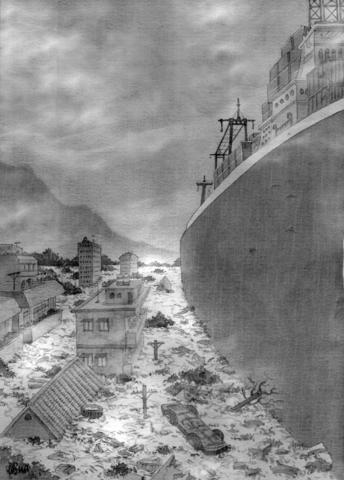Thailand's monsoon rains can sweep across Bangkok with a moment's notice, blacking out the sky and sparking floods that fill the street and then disappear just as quickly as they arrived.
Some 4,000mm of rain pours down on Thailand in a year, most of it between June and December, but shoddy management of the nation's water supply is causing shortages as agriculture, households and industry increase their demands, experts warn.
Demand for water could nearly double within 20 years, from 190 million cubic meters a year to 340 million cubic meters, one study at respected Mahidol University indicates.

ILLUSTRATION: YU SHA
Because rain doesn't fall evenly throughout the year, Thailand is also highly prone to drought. The just-ended dry season brought a drought that scorched 60 of the kingdom's 76 provinces.
To ease the problem, Prime Minister Thaksin Shinawatra said the military would drill 4,000 new drinking wells, and the government may ask its neighbors about diverting water from the Mekong river to help Thai farmers, a move which would require an agreement with China, Myanmar, Laos, Cambodia and Vietnam, which have also faced problems with drought
But such responses fail to address more pressing needs to change attitudes about water conservation, said environmental expert Kampanad Bhaktikul from Mahidol University.
What he describes as "a severe water shortage" has crept into Thailand over the last decade, with the public largely unaware, he said.
Drilling more wells is "the same as constructing a dam in the time of flood," he said, urging better water conservation.
"What we should do is long-term policy planning, a master plan of water resources development and management," Kampanad said.
People should be allowed more control over water resources in their home area, he said.
But letting local residents take charge of water in their neighborhood is not so simple, said Witoon Permpongsacharoen, who heads the lobby group Foundation for Ecological Recovery.
More than 100 rivers and basins criss-cross the country, but for the past century the Chao Praya river basin around Bangkok has dominated irrigation policy, Witoon said.
"This ignores each individual area's characteristics. The solution of water management should be based on local conditions," he said.
The royal irrigation department has drafted a new four-year national water management plan aimed at a fairer distribution to farmers, households and industry, the agency's chief Samart Chokkanapitark said.
The 200 billion baht (US$4.9 billion) plan, which needs Cabinet approval, covers 25 river basins and could be implemented starting next year.
The water supply problem is "serious," Samart said, because Thailand has enough water but not enough reservoirs and dams to collect it.
The department supplies an average 49,500 million cubic meters of water annually, but some 67,230 million cubic meters is demanded, Samart said.
To reduce the difference, the new plan calls for building dams and replacing leaky pipes, and urging farmers in some areas to replace rice crops with more water-efficient ones including corn or soya beans.
The scheme would also give locals a greater role in managing their water, and would increase Thais' water bills by adding on the cost of treating water. Bangkok residents currently only pay for the cost of using raw water.
Nationally, Thais use an average 200 liters of water per person a day, and 416 liters per person in the Bangkok metropolitan area, Kampanad said.
The figure for the city of more than 7 million people and its surrounding districts includes water used domestically and by industry, Kampanad said.

Donald Trump’s return to the White House has offered Taiwan a paradoxical mix of reassurance and risk. Trump’s visceral hostility toward China could reinforce deterrence in the Taiwan Strait. Yet his disdain for alliances and penchant for transactional bargaining threaten to erode what Taiwan needs most: a reliable US commitment. Taiwan’s security depends less on US power than on US reliability, but Trump is undermining the latter. Deterrence without credibility is a hollow shield. Trump’s China policy in his second term has oscillated wildly between confrontation and conciliation. One day, he threatens Beijing with “massive” tariffs and calls China America’s “greatest geopolitical
On Sunday, 13 new urgent care centers (UCC) officially began operations across the six special municipalities. The purpose of the centers — which are open from 8am to midnight on Sundays and national holidays — is to reduce congestion in hospital emergency rooms, especially during the nine-day Lunar New Year holiday next year. It remains to be seen how effective these centers would be. For one, it is difficult for people to judge for themselves whether their condition warrants visiting a major hospital or a UCC — long-term public education and health promotions are necessary. Second, many emergency departments acknowledge
US President Donald Trump’s seemingly throwaway “Taiwan is Taiwan” statement has been appearing in headlines all over the media. Although it appears to have been made in passing, the comment nevertheless reveals something about Trump’s views and his understanding of Taiwan’s situation. In line with the Taiwan Relations Act, the US and Taiwan enjoy unofficial, but close economic, cultural and national defense ties. They lack official diplomatic relations, but maintain a partnership based on shared democratic values and strategic alignment. Excluding China, Taiwan maintains a level of diplomatic relations, official or otherwise, with many nations worldwide. It can be said that
Chinese Nationalist Party (KMT) Chairwoman Cheng Li-wun (鄭麗文) made the astonishing assertion during an interview with Germany’s Deutsche Welle, published on Friday last week, that Russian President Vladimir Putin is not a dictator. She also essentially absolved Putin of blame for initiating the war in Ukraine. Commentators have since listed the reasons that Cheng’s assertion was not only absurd, but bordered on dangerous. Her claim is certainly absurd to the extent that there is no need to discuss the substance of it: It would be far more useful to assess what drove her to make the point and stick so